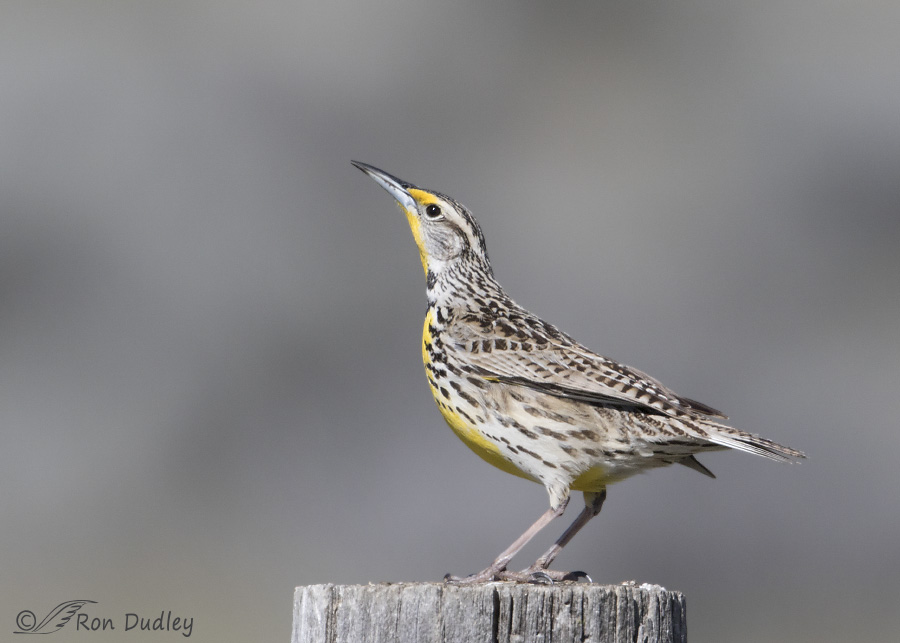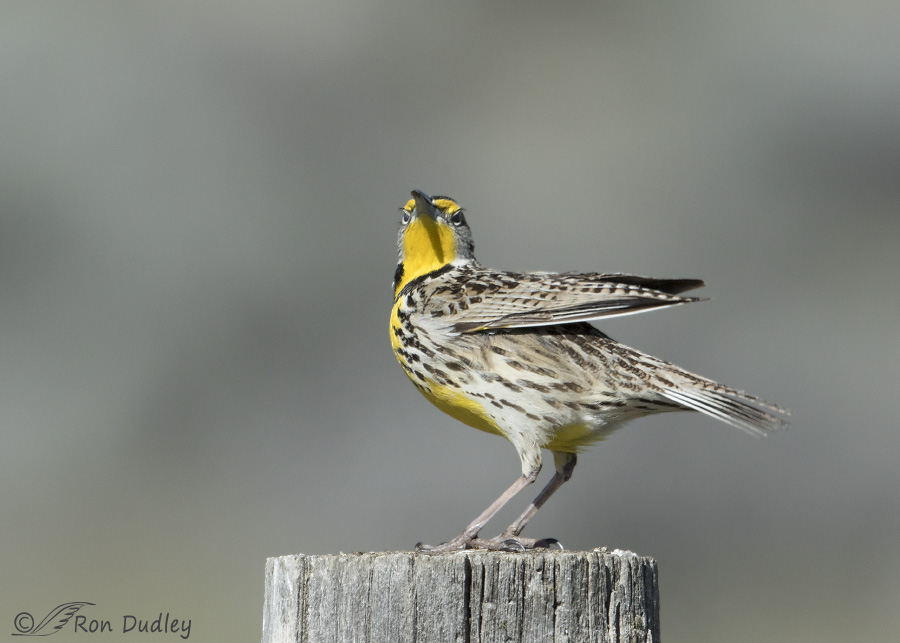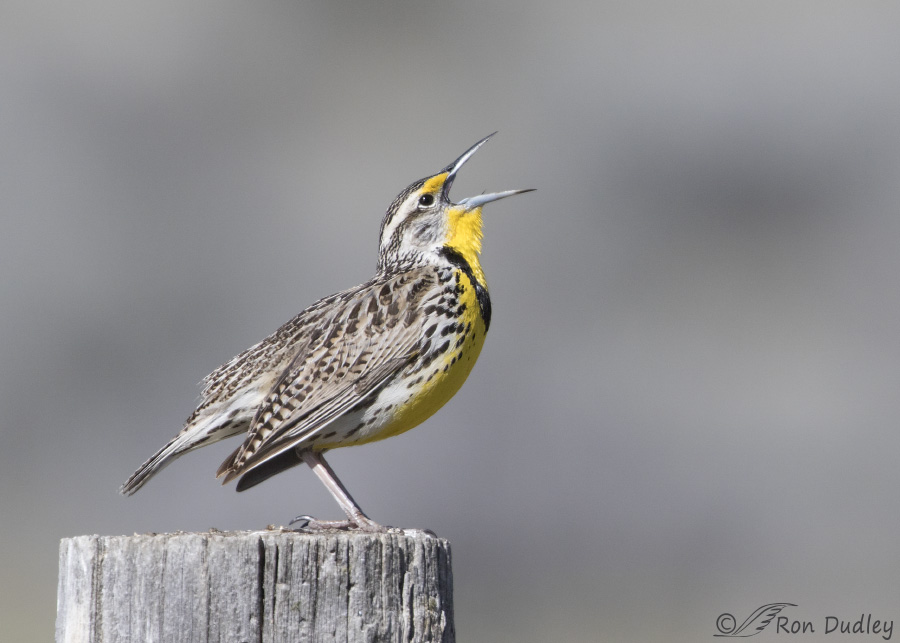I finally know the purpose behind this Western Meadowlark behavior. Typically I observe it several times each breeding season but until yesterday I never fully understood its significance.
In the springtime Western Meadowlarks are well known for singing their melodious, sweet song for extended periods – usually on territory and on elevated perches. Their song is one of the most distinctive and loved sounds in nature. But three days ago this bird was singing a different tune and acting oddly.
1/3200, f/7.1, ISO 500, Canon 7D Mark II, Canon EF 500mm f/4L IS II USM + EF 1.4 III Extender, not baited, set up or called in
The behavior had three components and “bill-tilting” was one of them where the bird would snap its bill upward. In meadowlarks it’s a quick behavior but in other icterids (a family of birds that includes meadowlarks, orioles, blackbirds and grackles among others) that position is often held for some time. Just yesterday I watched male Great-tailed Grackles performing bill-tilting and those birds held the position for several seconds.
1/3200, f/7.1, ISO 500, Canon 7D Mark II, Canon EF 500mm f/4L IS II USM + EF 1.4 III Extender, not baited, set up or called in
Interspersed with the bill-tilting this bird was flashing its wings partly open and shut with incredible speed – so fast that it was extremely difficult to anticipate and photograph. I fired multiple bursts to try to capture it and was only successful twice – this is the best of the two shots. At the same time it was flashing its wings it was snapping its white outer tail feathers in and out but I never did capture that very well.
The third component of this complex behavior was the odd call it was making the entire time. In the approximate two minutes the bird performed the behavior it never did sing its classical song – instead it was making its odd “chupp” call (I called it a chirp while I was watching it). That call can be heard here if you have the interest – scroll down to the 4th sound clip labeled “chupp call”.
This combined behavior is one side of a territorial dispute and is performed when a trespasser enters another birds territory. The bird faces its opponent during the display to present its yellow breast with black crescent to the intruder. I never did see the other bird but I strongly suspect it was there because this bird faced the same direction for the entire time it was displaying.
1/3200, f/7.1, ISO 500, Canon 7D Mark II, Canon EF 500mm f/4L IS II USM + EF 1.4 III Extender, not baited, set up or called in
Then suddenly the meadowlark turned 90° on its perch and began to sing its classical song with enthusiasm. It never displayed again while I was there. I presume that change in behavior was due to the other bird flying off.
I’ve seen this display multiple times over the years but until yesterday I’d never taken the time to research its significance. Following is what Birds of North America Online has to say about it:
- “Two forms of posturing used in territorial disputes. Bill-tilting, described for several icterid genera ( Andrew 1961 ), with feathers compressed and frequent jerking of bill upward; but rarely is pose “statuelike” for any length of time as in some icterids ( Williams 1952b ). Tail- and Wing-flashing may accompany Bill-tilting and often are initial reactions to trespasser; white outer rectrices nervously snapped out and in while wings are flashed open and shut with great speed. Often synchronized with each flash is the chupp call. Yellow breast and black crescent are presented to opponent.”
I didn’t get the best photos to illustrate the behavior but I think they’re good enough for documentary purposes. And I always feel fulfilled to some degree when I learn something new (to me) about birds – especially when I’ve seen and photographed the behavior in the field.
Next time I’ll look for the other bird…
Ron





Incredible! Can i borrow your camera? lens? truck? talent?
How can you disparage that last shot in any way???? It’s a beauty!!! You have to be genuinely nuts to find any fault with it (this is not the first, and probably not the last time I’vd had concerns ablut either your eyesight..or your sanity!)…
I DIDN’T disparage that lost shot – not one bit. What I said was “I didn’t get the best photos to illustrate the behavior” – referring to the territorial display behavior, not the singing photo. I like that last shot.
I believe my tenuous hold on relative sanity is still fairly intact…
So often I start my day by learning from you, marvelling at the beauty you find and display. Thank you so much.
I’m always happy to contribute to a good beginning to your day, EC. Thank you.
Super shots Ron!
Charlotte
Thanks, Charlotte.
Good info. I note that grackles tend to do a lot of bill-tilting!
…And seed and suet stuffing! They can clean us out pretty darned fast! Have very mixed feelings when they mob our feeders…especially since one of my favorite hand-raised orphans was “Jack the Grack”–very, very smart… and funny!!!
I seem to have found a way to cure the grackle mobbing to quite a degree – I changed my suet feeder to an “upside down” model. It took some time for the upside down birds to find it but eventually most find a way – it helps if you have chickadees around!
They sure do. Yesterday I watched about a half-dozen male grackles doing it on the ground at a local pond.
love the description “Singing sunshine” for the meadowlarks! lovely sunshine pictures.
I agree, Beth. Patty often comes up with good stuff like that.
Love meadowlarks and their gorgeous melodies! Your images are wonderful — what an interesting territorial display. Zooming in on the second one with bird facing camera, it looks to me like he’s got eyelashes or eyebrows. That’s quite a haughty look on his face!
I think you’re right, Chris. I see them too.
Another gray day here, but changed quickly with today’s Meadowlark blog…they always brighten my day..”Singing Sunshine”…they sound so joyous! How great to hear some of their songs, agai !!! Intersting behavior…wing and tail feather “shuffling” must be equivalent to flexing one’s muscles, but am curious about the bill-tilting…
I’ll bet you’re pretty close with that muscle flexing analogy, Patty.
What a perfect name for them, Patty!
Delightful! And thanks so much for the link to the birdsong. I downloaded the 5 delightful songs that Cornell offers if one provides one’s name and contact info. I’m so glad you can hear the Western Meadowlark in the freshness of the morning moment…
Alison, the number of meadowlarks on Antelope Island (not where these shots were taken) is almost beyond belief. I can often hear a dozen or more of them singing at the same time. That place is legendary for meadowlarks.
I am SO JEALOUS!!!!!!!
Very interesting! I wonder if this behavior could be found with other species when acting in similar circumstances? Or primarily in plains species?
Great post, thanks for sharing.
I don’t know, Dick. Personally I’ve only seen the entire behavior (all three components) in meadowlarks, although other icterids do perform the bill-tilting.
Interesting – have never given their behavior much thought as it’s usually seeing/hearing them on a fence post while passing in a vehicle. Always something to learn.
Judy, it’s significantly easier for me to spot these types of behaviors because I’m usually watching the birds “up close” through my lens.
Cool! Chupping and tilting and flashing. Very interesting and thanks, Ron.
Thanks, Art. If you have meadowlarks in your area you might want to watch for the behavior – it’s fairly common this time of year.
I spoke too soon.
Brautiful!
Thanks, Lynn.
Wow! Fascinating! Especially the abrupt transition once the perceived threat was gone. Great behavioral capture, Ron.
Marty, that transition was obvious – especially since it turned on its perch and started singing its “normal” song as soon as it quit displaying. Sure wish I’d looked for the presumed other bird…